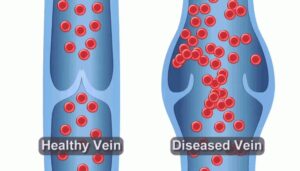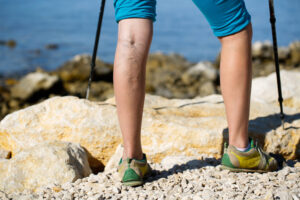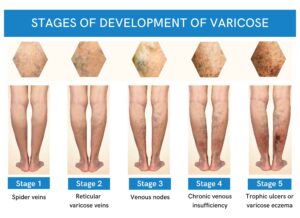Varicose Veins & Spider Veins
What is Venous Reflux Disease?
Healthy leg veins contain valves that open and close to assist the return of blood back to the heart. Venous reflux disease develops when the valves that keep blood flowing out of the legs and back to the heart no longer function, causing the blood to pool in the legs.
Signs and symptoms of venous reflux disease:
- Varicose Veins and spider veins
- Leg or ankle swelling

- Leg heaviness and fatigue
- Leg pain, aching or cramping
- Burning or itching of the skin
- Restless legs
- Skin changes or rashes
- Ulcers, open wounds, or sores
Who suffers from vein disease?
Many factors contribute to the presence of venous reflux, including:
- Family history
- Sedentary lifestyle
- Trauma
- Current or previous pregnancies
- Excess weight
- Prolonged standing
- Smoking
Treatment Options
TRA Endovascular offers a wide range of minimally invasive, outpatient procedures to treat vein and vascular issues. During a free consultation, one of our expert providers may suggest a particular procedure or treatment to address specific concerns. Services offered at TRA Endovascular include:
-
Adhesive Venous Closure
-
Adhesive Venous Closures, contrary to radiofrequency or other heat-based vein treatments, uses medical grade glue to close veins.
Adhesive venous closure is beneficial for patients looking for a minimal recovery time, allowing them to return to normal activities following a short recovery. There is no chance of nerve damage or thermal injuries and no need for anaesthetic. VenaSeal is not covered by Medicare, so talk to your provider about what procedure works best for you.
Prior to the procedure, one of our radiologists will evaluate the veins using ultrasound. VeraSeal Vein Glue (cyanoacrylate) is used to seal veins, blocking blood flow making the vein harden to be absorbed back into the tissue. The procedure is minimally invasive, requires small amounts of anesthesia.
There is little to no recovery time for adhesive venous closure, and most patients do not require post-treatment medications or compression socks. Because a glue is used to close veins rather than heat there is no risk of heat damage such as nerve damage or burns.
Patients will see results shortly after the procedure, with excellent long-term results and 98% closure rate six months post-treatment. Surface veins may need to be treated 2-4 weeks after an adhesive venous closure.
-
Ambulatory Phlebectomy
-
Ambulatory phlebectomy is an outpatient surgical procedure in which a provider uses a hook to remove varicose veins out of the leg. The procedure treats both asymptomatic and symptomatic varicose veins, usually larger veins.
Ambulatory phlebectomy is a more invasive procedure, as the entire vein is removed during treatment, and is recommended only for select patients who cannot receive a less invasive vein treatment.
During the procedure, the radiologist will use a local anesthetic and create tiny incisions next to vein, which will be used to pull the vein out. The procedure takes about an hour and once completed, the incisions are closed and the treated area is wrapped in a bandage or covered with a compression stocking.
With the immediate removal of the affected vein, patients experience immediate changes in associated symptoms like skin sores, leg swelling, bleeding and blood clots. Patients will also notice an improvement in the appearance of the affected area within days.
Patients can resume normal daily activities following the procedure, applying antibiotic to the treated area for the following week or so. Most patients recover within two weeks, but may experience some bruising or small bumps under the skin where the vein was extracted.
-
Radiofrequency Venous Ablation
-
Radiofrequency venous ablation is a minimally invasive treatment used to close veins. Ablation refers to the technique of closing a vein through creating scar tissue.
Some veins cannot be treated with RFA: large visible varicose veins, reticular veins and thread veins. Consulting with a radiologist prior to treatment will best assess if RFA is a good fit for you.
During the procedure, a provider will insert a catheter (a thin, flexible tube) into the vein via a small incision. Using radiofrequency energy to generate heat and damage venous tissue, the treated veins will begin to scar and close, eventually fading back into the skin tissue.
Risks involved with radiofrequency venous ablation are minimal, some side effects could include skin burns, minor nerve damage creating a burning or prickling pain sensation or blood clotting.
Patients are able to walk post-treatment and the recovery period is short. About a week after the procedure, patients will return for an ultrasound to ensure the veins are scarring and fading correctly.
-
Cosmetic Sclerotherapy Injection
-
Cosmetic sclerotherapy is a non-invasive medical procedure used to treat small varicose veins and spider veins that are close to the surface of the skin. During the procedure, a solution called a sclerosant, Sodium Tetraecyl Sulfate, is injected directly into the affected veins using a very fine needle. The solution irritates the inner lining of the vein, causing it to collapse and stick together. The veins will respond to treatment within 3 – 6 weeks, closing and fading back into the body.
The procedure may take several sessions, depending on the extent and severity of the vein problem.
Common side effects may include temporary bruising, swelling, or redness at the injection site.
-
Ultrasound-Guided Sclerotherapy
-
Ultrasound guided sclerotherapy injects a salt solution – sclerosant – into the veins to block blood flow, collapse and absorb back into the body’s tissue. The non-surgical treatment uses an ultrasound before to evaluate veins and during to ensure all veins are treated effectively.
Some patients are not qualified to receive this treatment, including pregnant, breastfeeding or individuals who are bedridden. People who recently gave birth must wait three months after delivery before being eligible for cosmetic sclerotherapy.
During the procedure, sclerosant is injected into the affected veins, which is a Sodium Tetraecyl Sulfate. The veins will respond to treatment within three to six weeks, closing and fading back into the body. The procedure takes approximately 15 to 20 minutes with little to no recovery time.
Patients will be reviewed a week or so following the procedure with another ultrasound to guarantee veins are fading and healing as they should be and to treat any residual veins.
What Results Can You Expect?
Most patients start to feel better the day after the procedure. They will notice the symptoms related to their venous disease decrease. Over the span of a few weeks after the venous procedure, symptoms should be significantly improved. Many of the skin changes to venous disease can be reversed with treatment.
What are the Risks Without Treatment?
Venous reflux disease is a progressive medical condition and if left untreated, may lead to worsening symptoms, skin changes, and in a small set of patients, venous ulcers.
Insurance Coverage for Vein Treatment
Patients do not need a referral to see one of our vein specialists.
Most insurances cover vein treatment. Many require a trial of compression stockings prior to any procedure. Learn more about the path to vein treatment.
Request a Free Vein Screening
Fill out our request form below for more information or to schedule your free, virtual screening!
Request a Free Vein ScreeningAdditional Resources: Radiologyinfo.org


